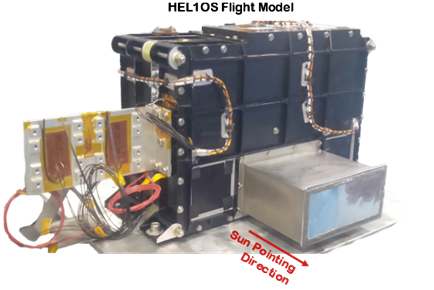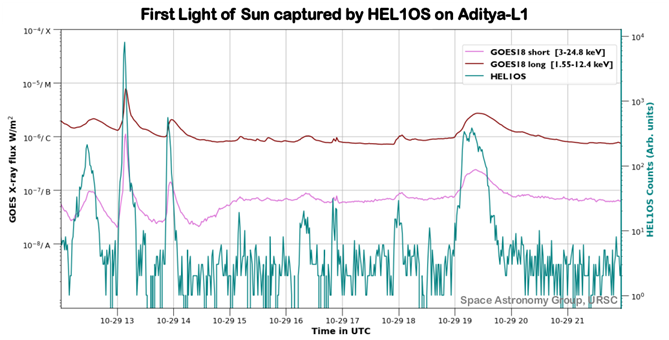High Energy L1 Orbiting X-ray
Spectrometer (HEL1OS), is the hard X-ray spectrometer on Aditya-L1
Solar Mission by ISRO, operating in the wide X-ray energy band of 10
– 150 keV. It is the harbinger of flaring activities on the Sun,
with the ability to capture the early impulsive phase of the solar
activity.
A solar flare is a sudden brightening of the solar atmosphere, which
involves 1027 – 1032 ergs of energy release in tens of minutes.
Flares produce enhanced emission in all wavelengths across the
electromagnetic spectrum – radio, optical, UV, soft X-rays, hard
X-rays and gamma-rays. Flare emission consists of emissions from
accelerated particles and hot plasma. Though solar flares have been
studied in X-rays and gamma-rays for decades, the initial impulsive
emission is very difficult to characterise and understand. The
impulsive hard X-ray emission has multiple spectral components which
are highly time variable. Further, the spectrum is very steep, the
emission above 20 keV is typically several orders of magnitude
(about a million times) lower than that of the emission below 10
keV. HEL1OS aims to overcome these difficulties by having a set of
detectors specifically tuned to cater to different energy ranges and
also provides very high spectral and time resolution measurements.
Science goals of HEL1OS:
-
Study of explosive energy release, acceleration
and transport of electrons during Solar flares using fast timing
measurements and high resolution spectra.
-
Quasi-periodic Pulsations (QPPs) of hard X-rays
during Solar flares to understand its connection with particle
acceleration mechanisms.
 HEL1OS is designed with two different types of detectors – (a) Cadmium Telluride (CdTe) operating in 10 – 40 keV band and, (b) Cadmium Zinc Telluride (CZT) operating in 20 – 150 keV band. The CZT detector is a state-of-the-art, near room temperature device; in order to achieve a total geometric area of 32 cm2 (4 cm x 4 cm per module), two such detectors are used to cover the energy range 20 keV to 150 keV. The individual detectors are pixelated with 256 pixels, with pixel dimension 2.46 mm x 2.46 mm. The CdTe detector, which has better energy resolution at lower energies, is used for spectroscopic studies from 10 keV to 40 keV. The overall geometric area of 0.5 cm2 will be achieved by using 2 CdTe detectors, each with area 0.25 cm2. As mentioned before, these two different detectors are required to fulfill the scientific necessity of covering the overlap between thermal and non-thermal components of a solar flare.
HEL1OS is designed with two different types of detectors – (a) Cadmium Telluride (CdTe) operating in 10 – 40 keV band and, (b) Cadmium Zinc Telluride (CZT) operating in 20 – 150 keV band. The CZT detector is a state-of-the-art, near room temperature device; in order to achieve a total geometric area of 32 cm2 (4 cm x 4 cm per module), two such detectors are used to cover the energy range 20 keV to 150 keV. The individual detectors are pixelated with 256 pixels, with pixel dimension 2.46 mm x 2.46 mm. The CdTe detector, which has better energy resolution at lower energies, is used for spectroscopic studies from 10 keV to 40 keV. The overall geometric area of 0.5 cm2 will be achieved by using 2 CdTe detectors, each with area 0.25 cm2. As mentioned before, these two different detectors are required to fulfill the scientific necessity of covering the overlap between thermal and non-thermal components of a solar flare.
HEL1OS has been developed by the Space Astronomy Group of the U. R. Rao Satellite Centre, ISRO, Bengaluru, in collaboration with different entities of the centre.
First Light of Sun captured by HEL1OS
HEL1OS was commissioned on Oct 27, 2023 and it has been monitoring the Sun for hard X-ray activities ever since.
The plot here is the X-ray light curve detected by HEL1OS of the Solar activity during ~ 12:00 to 22:00 UT on October 29, 2023, along with GOES X-ray light curves in the same interval for comparison. The strongest event is the C6 class flare at 13:00 UT. The impulsive phase of the solar flare is evident in the HEL1OS light curve, distinguishable from the GOES observation by its short time duration and earlier peaking time, i.e the time at which "peak" or "maximum" X-rays in an energy range are detected. The HEL1OS light curve also shows evidence of a few impulsive events which are weak in the GOES light curve. Detailed analysis of HEL1OS data will be able to tell whether or not any interesting evidence of electron acceleration is present in these weak GOES events.

|
|








 HEL1OS is designed with two different types of detectors – (a) Cadmium Telluride (CdTe) operating in 10 – 40 keV band and, (b) Cadmium Zinc Telluride (CZT) operating in 20 – 150 keV band. The CZT detector is a state-of-the-art, near room temperature device; in order to achieve a total geometric area of 32 cm2 (4 cm x 4 cm per module), two such detectors are used to cover the energy range 20 keV to 150 keV. The individual detectors are pixelated with 256 pixels, with pixel dimension 2.46 mm x 2.46 mm. The CdTe detector, which has better energy resolution at lower energies, is used for spectroscopic studies from 10 keV to 40 keV. The overall geometric area of 0.5 cm2 will be achieved by using 2 CdTe detectors, each with area 0.25 cm2. As mentioned before, these two different detectors are required to fulfill the scientific necessity of covering the overlap between thermal and non-thermal components of a solar flare.
HEL1OS is designed with two different types of detectors – (a) Cadmium Telluride (CdTe) operating in 10 – 40 keV band and, (b) Cadmium Zinc Telluride (CZT) operating in 20 – 150 keV band. The CZT detector is a state-of-the-art, near room temperature device; in order to achieve a total geometric area of 32 cm2 (4 cm x 4 cm per module), two such detectors are used to cover the energy range 20 keV to 150 keV. The individual detectors are pixelated with 256 pixels, with pixel dimension 2.46 mm x 2.46 mm. The CdTe detector, which has better energy resolution at lower energies, is used for spectroscopic studies from 10 keV to 40 keV. The overall geometric area of 0.5 cm2 will be achieved by using 2 CdTe detectors, each with area 0.25 cm2. As mentioned before, these two different detectors are required to fulfill the scientific necessity of covering the overlap between thermal and non-thermal components of a solar flare.